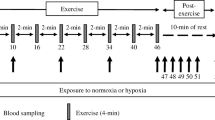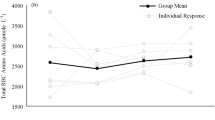Summary
Relations among exercise acidosis and various electrolyte concentrations in plasma of femoral venous blood were investigated during bicycling. At equal work rates the changes in endurance trained athletes were compared with the changes in non-athletes. The increase of [Ca++] and [Mg++] could be explained by hemoconcentration. In untrained [H+], [K+], [orthophosphate] (P i ), [lactate] (Lac) and [protein] (Prot) increased significantly more than in trained subjects. Actual [HCO3 −] rose at low work rates, at higher rates it decreased in the untrained while remaining constant in the athletes. [Cl−] did not change during work. Na+ shift into the working muscles must occur. A high correlation does exist between [H+] and [K+], [P i ] and Na+ shift, respectively. This confirms the concept of a strong interaction between the H+ and the Na+−K+ transport. Probably P i follows K+ through the cell membrane. From the ratio of K+ and P i release it might be possible to calculate the intracellular pH. The calculated osmolality (Osm) increased more in untrained than in trained subjects primarily caused by changes in [Lac−] and [HCO3 −].
Similar content being viewed by others
References
Abrams, W. B., Lewis, D. W., Bellet, S.: The effect of acidosis and alkalosis on the plasma potassium concentration and the electrocardiogram of normal and potassium depleted dogs. Amer. J. med. Sci.222, 506–515 (1951)
Adler, S., Roy, A., Relman, A. S.: Intracellular acid-base regulation. I. The response of muscle cells to changes in CO2 tension or extracellular bicarbonate concentration. J. clin. Invest.44, 8–20 (1965)
Ahlborg, B., Bergström, J., Ekelund, L. G., Hultmann, E.: Muscle glycogen and muscle electrolytes during prolonged physical exercise. Acta physiol. scand.70, 129–142 (1967)
Astrup, P.: A simple electrometric technique for the determination of carbondioxide tension in blood and plasma, total content of carbon-dioxide in plasma and bicarbonate content in “separated” plasma at a fixed carbon-dioxide tension (40 mm Hg). Scand. J. clin. Lab. Invest.8, 33–43 (1956)
Bärtschi, F., Haab, P., Held, D. R.: Reliability of bloodpCO2-measurements by the CO2-electrode, the whole blood CO2/pH method and the Astrup method. Resp. Physiol.10, 121–131 (1970)
Bittar, E. E., Watt, M. F., Pateras, V. R., Parrish, A. E.: The pH of muscle in Laennec's cirrhosis and uremia. Clin. Sci.23, 265–276 (1962)
Böning, D., Schweigert, U., Tibes, U., Hemmer, B.: “In vivo” and “in vitro” investigations on the oxygen dissociation curve of blood of trained and untrained subjects during exercise. Pflügers Arch.332, Suppl. R78 (1972)
Cain, D. F., Infante, A. A., Davies, R. E.: Chemistry of muscle contraction, adenosine triphosphate and phosphorylcreatine as energy supplies for single contractions of working muscle. Nature (Lond.)196, 214–217 (1962)
Davies, R. E., Keynes, R. D.: A coupled sodium—potassium pump. In: Membrane Transport and Metabolism, p. 336. New York: Academic Press 1961
De Lanne, R., Barnes, J. R., Brouha, L.: Changes in osmotic pressure and ionic concentrations of plasma during muscular work and recovery. J. appl. Physiol.14, 804–808 (1959)
Dill, D. B., Talbott, J. H., Edwards, H. T.: Studies in muscular activity. VI. Response of several individuals to a fixed task. J. Physiol. (Lond.)69, 267–305 (1930)
Documenta Geigy Wissenschaftliche Tabellen, 6. Aufl. Basel 1960
Ewig, W., Wiener, R.: Über die Wirkungen maximaler körperlicher Anstrengungen. V. Der Einfluß einer einmaligen maximalen Anstrengung auf die chemische Blutzusammensetzung. Z. ges. exp. Med.61, 562–589 (1928)
Farber, S. J., Pellegrino, E. D., Conan, N. J., Earle, D. P.: Observations on the plasma potassium level of man. Amer. J. med. Sci.221, 678–687 (1951)
Fenn, W. O.: Loss of potassium in voluntary contraction. Amer. J. Physiol.120, 675–680 (1937)
Fenn, W. O.: The deposition of potassium and phosphate with glycogen in rat livers. J. biol. Chem.128, 297–307 (1939)
Grob, D., Liljestrand, Ä., Johns, R. J.: Potassium movement in normal subjects. Effect on muscle function. Amer. J. Med.23, 340–355 (1957)
Henderson, L. J.: Blut — seine Pathologie und Physiologie, dtsch. von M. Tennenbaum. Dresden-Leipzig 1932
Hill, A. V.: Muscular activity. The Herter Lectures for 1924. Baltimore: The Williams and Wilkins Co. 1926
Hinsberg, K., Lang, K.: Medizinische Chemie für den klinischen und theoretischen Gebrauch. München-Berlin-Wien: Urban & Schwarzenberg 1957
Hodgkin, A. L., Horowitz, P.: Movements of Na and K in single muscle fibres. J. Physiol. (Lond.)145, 405–432 (1959)
Hultman, E.: Physiological role of muscle glycogen in man, with special reference to exercise. Suppl. I to Circulat. Res. XX and XXI, I-99–I-114 (1967)
Irvine, R. O. H., Dow, J.: Muscle cell pH and potassium movement in metabolic acidosis. Metabolism17, 563–570 (1968)
Karlsson, J.: Lactate and phosphagen concentrations in working muscle of man. Acta physiol. scand., Suppl. 358 (1971)
Keynes, R. D.: Dependence of the sodium efflux from frog muscle on internal sodium concentration and internal pH. J. Physiol. (Lond.)166, p. 16–17 (1963)
Kilburn, K. H.: Muscular origin of elevated plasma potassium during exercise. J. appl. Physiol.21, 675–678 (1966)
Koller, S.: Statistische Auswertung der Versuchsergebnisse. In: Handb. physiol. pathol.-chem. Anal., edit. by K. Lang and E. Lehnartz, vol. 2, pp. 931–1036. Berlin-Göttingen-Heidelberg: Springer 1955
Kraus, H., Kirsten, R., Wolff, J. R.: Die Wirkung von Schwimm- und Lauf-training auf die celluläre Funktion und Struktur des Muskels. Pflügers Arch.308, 57–79 (1969)
Kutscha, W., Pauschinger, P., Brecht, K.: Der Einfluß der H-Ionen auf Elektrolytgehalt, Membranpotential und Kontraktion tonischer und phasischer Skeletmuskeln. Pflügers Arch. ges. Physiol.280, 1–21 (1964)
Linder, A.: Statistische Methoden für Naturwissenschaftler, Mediziner und Ingenieure. Basel-Stuttgart: Birkhäuser 1957
Maschio, G., Bazzato, G., Bertalia, E., Sardini, D., Mioni, G., D'Angelo, A., Marzo, A.: Intracellular pH and electrolyte content of skeletal muscle in patients with chronic renal acidosis. Nephron7, 481–487 (1970)
Mudge, G. H., Vislocky, K.: Electrolyte changes in human striated muscle in acidosis and alkalosis. J. clin. Invest.28, 482–486 (1949)
Nylin, G.: The effect of heavy muscular work on the volume of circulating red corpuscle in man. Amer. J. Physiol.149, 180–184 (1947)
Poortmans, J. R.: Serum protein determination during short exhaustive physical activity. J. appl. Physiol.30, 190–192 (1971)
Rooth, G.: Acid-base, electrolyte and water changes during tissue hypoxia in rats. Clin. Sci.30, 417–424 (1966)
Rougier, G., Babin, J. P.: Influence des activités physiques sur les electrolytes sériques et musculaires. Path.-Biol.17, 411–427 (1969)
Scribner, B. H., Burnell, J. M.: Symposium: Water and electrolytes. I. Interpretation of the serum potassium concentration. Metabolism5, 468–479 (1956)
Siggaard-Andersen, O., Engel, K.: A new acid-base nomogram. An improved method for the calculation of the relevant blood acid-base data. Scand. J. clin. Lab. Invest.12, 177–186 (1960)
Simmons, H. D., Avedon, M.: Acid-base alterations and plasma potassium concentration. Amer. J. Physiol.197, 319–326 (1959)
Sréter, F. A.: Distribution of water, sodium and potassium in resting and stimulated mammalian muscle. Canad. J. Biochem. Physiol.41, 1035–1045 (1963)
Stryjecka-Rowinska, P.: Intracellular pH of skeletal muscles in dog in health and in metabolic acidosis. Bull. Acad. Sci. Pol. Bio.19, 517–520 (1968)
Varnauskas, E., Björntorp, P., Fahlen, M., Prerovsky, I., Sternberg, J.: Effects of physical training on exercise blood flow and encymatic activity in skeletal muscle. Cardiovasc. Res4, 418–422 (1970)
Volle, R. L., Glisson, S. N., Henderson, E. G.: Influence of H+ on42K-exchange in sartorius muscle treated with barium or aminoacridine. Pflügers Arch.337, 241–256 (1972)
Author information
Authors and Affiliations
Additional information
Supported by Bundesinstitut für Sportwissenschaften, 5023 Lövenich.
Rights and permissions
About this article
Cite this article
Tibes, U., Hemmer, B., Schweigart, U. et al. Exercise acidosis as cause of electrolyte changes in femoral venous blood of trained and untrained man. Pflugers Arch. 347, 145–158 (1974). https://doi.org/10.1007/BF00592396
Received:
Issue Date:
DOI: https://doi.org/10.1007/BF00592396




